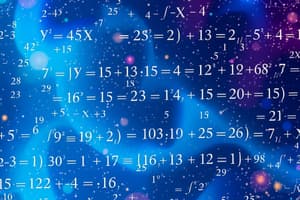Podcast
Questions and Answers
Match the following rational numbers with their equivalent forms:
Match the following rational numbers with their equivalent forms:
- = 10/10 0 = 10/10 -2 = -20/10 -5/6 = -20/24
Match the following statements with their explanations:
Match the following statements with their explanations:
Rational numbers can be found between any two given rational numbers = Countless rational numbers can be found between two rational numbers -2 can be written as -20/10 = Conversion of rational numbers to equivalent forms 0 can be written as 0/10 = Conversion of rational numbers to equivalent forms Countless rational numbers can be found between -2 and 0 = Rational numbers can be found between any two given rational numbers
Match the following with their corresponding numerators:
Match the following with their corresponding numerators:
- = -10 0 = 0 -5/6 = -20 -2 = -20
Match the following rational numbers with their denominators:
Match the following rational numbers with their denominators:
Match the following rational numbers with their equivalent forms:
Match the following rational numbers with their equivalent forms:
Match the following with their corresponding explanations:
Match the following with their corresponding explanations:
Match the following with their corresponding properties:
Match the following with their corresponding properties:
Match the following with their corresponding characteristics:
Match the following with their corresponding characteristics:
Match the following expressions with their simplified forms:
Match the following expressions with their simplified forms:
Match the following expressions with the properties used to simplify them:
Match the following expressions with the properties used to simplify them:
Match the following numbers with their additive inverses:
Match the following numbers with their additive inverses:
Match the following values of x with the verification of the equation -(-x) = x:
Match the following values of x with the verification of the equation -(-x) = x:
Match the following numbers with their multiplicative inverses:
Match the following numbers with their multiplicative inverses:
Match the following expressions with their equivalent forms:
Match the following expressions with their equivalent forms:
Match the following equations with their solutions:
Match the following equations with their solutions:
Match the following expressions with their correct orders of operations:
Match the following expressions with their correct orders of operations:
Match the property with the correct operation for rational numbers:
Match the property with the correct operation for rational numbers:
Match the operation with the correct statement for rational numbers:
Match the operation with the correct statement for rational numbers:
Match the expression with the correct calculation for rational numbers:
Match the expression with the correct calculation for rational numbers:
Match the operation with the correct characteristic for rational numbers:
Match the operation with the correct characteristic for rational numbers:
Match the statement with the correct operation for rational numbers:
Match the statement with the correct operation for rational numbers:
Match the operation with the correct example for rational numbers:
Match the operation with the correct example for rational numbers:
Match the operation with the correct reason for rational numbers:
Match the operation with the correct reason for rational numbers:
Match the operation with the correct result for rational numbers:
Match the operation with the correct result for rational numbers:
Flashcards are hidden until you start studying
Study Notes
Commutative Properties of Rational Numbers
- Addition is commutative for rational numbers, meaning that the order of numbers does not change the result: a + b = b + a.
- Subtraction is not commutative for rational numbers, meaning that the order of numbers changes the result: a - b ≠ b - a.
- Multiplication is commutative for rational numbers, meaning that the order of numbers does not change the result: a × b = b × a.
- Division is not commutative for rational numbers, meaning that the order of numbers changes the result: a ÷ b ≠ b ÷ a.
Rational Numbers Between Two Given Numbers
- There are countless rational numbers between any two given rational numbers.
- Example: Find three rational numbers between -2 and 0. Solution: Convert -2 and 0 to rational numbers with the same denominators, and then find rational numbers between them.
- Example: Find ten rational numbers between -5/6 and 5/8. Solution: Convert -5/6 and 5/8 to rational numbers with the same denominators, and then find rational numbers between them.
Multiplication of Rational Numbers
- The commutative property of multiplication can be used to simplify multiplication of rational numbers.
- Example: Find the value of (2 -3 × (-1 × 3 - 3)) × (- 3/5).
- Solution: Use the commutative property of multiplication to simplify the expression.
Exercise 1.1
- Problems involve using properties of rational numbers to simplify expressions.
- Examples: Find the value of expressions such as (-2 × 3/5 + 3/2 × -5/6) and (-3/7 × 2/5 - 1/2 × 3/7).
- Problems also involve finding additive inverses and multiplicative inverses of rational numbers.
Studying That Suits You
Use AI to generate personalized quizzes and flashcards to suit your learning preferences.




